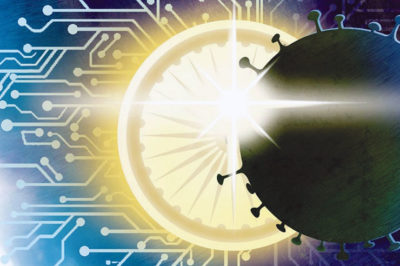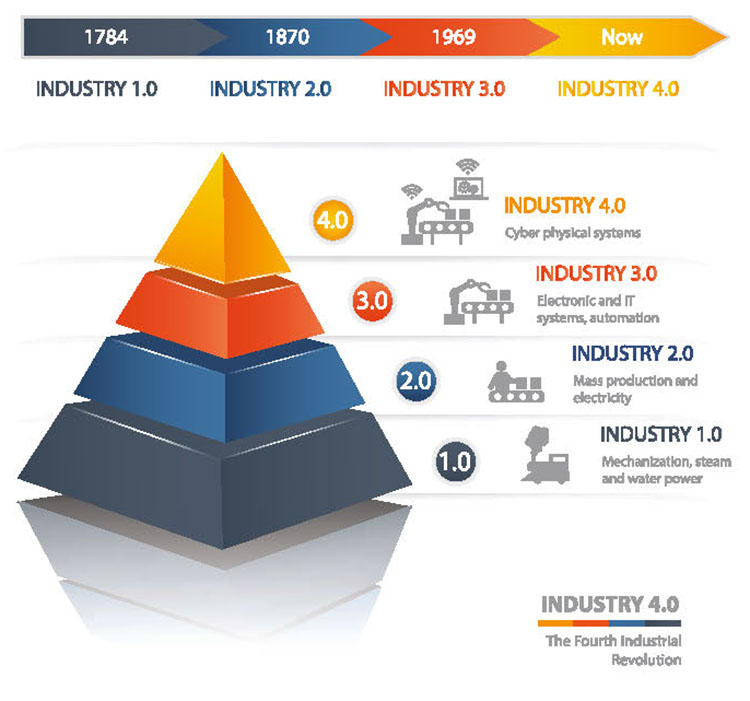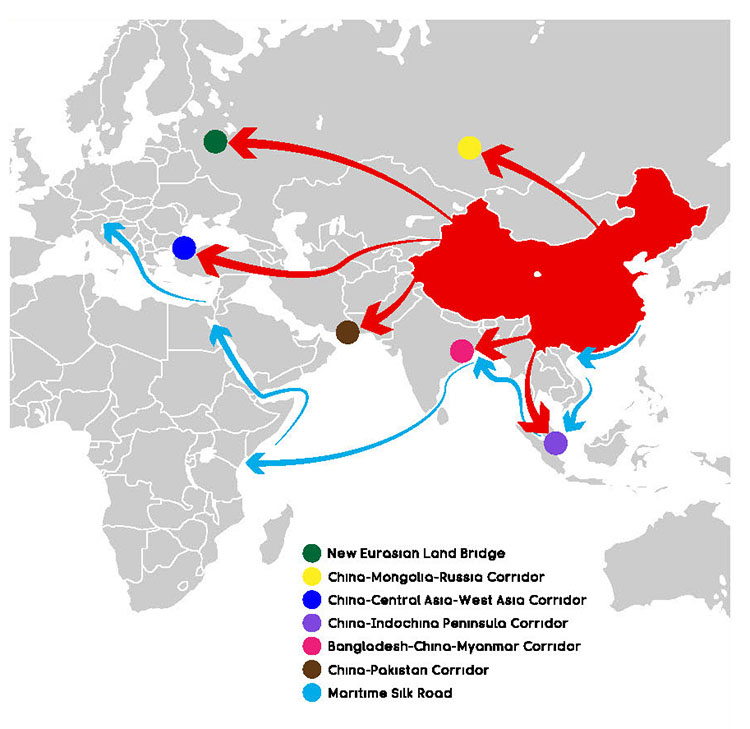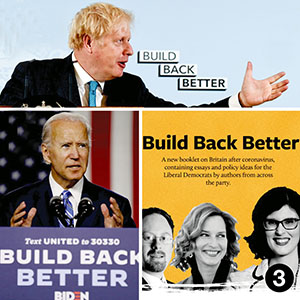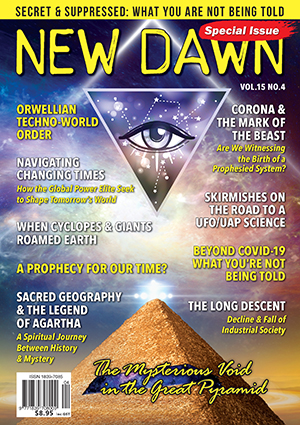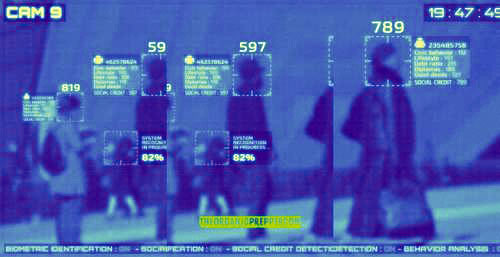From New Dawn Special Issue Vol 15 No 4 (Aug 2021)
In Nineteen Eighty-Four, George Orwell described three competing tyrannies: Oceania, Eastasia, and Eurasia. As the great powers fight endless wars (or so their publics are told), the domestic population of Oceania is suppressed by Big Brother’s omniscient surveillance, the Ministry of Truth’s dictation of reality, and the compliance of the public, who report any dissent to the ruling Ingsoc party. It has long been a cliché to say that we live in Orwellian times.
The first Cold War lasted roughly from 1945 to 1991, with the collapse of the Soviet Union. The second began in 2000 with the election of Russia’s President Vladimir Putin and continues to the present. Examples of events that support a Cold War 2.0 hypothesis include proxy wars on Russia’s borders (Ukraine) and against its allies (Syria), as well as accusations that Russia is interfering in Euro-American politics (election hacking). The mounting war against China can either be seen as part of the overall nexus of Cold War 2.0, perhaps Cold War 2.1, or as a Cold War 3 with an entirely different set of dynamics. For instance, blaming China for the Covid virus is far more serious than accusing Russia of meddling in foreign elections.
Covid has been used as an excuse by both the US administrative state and the Chinese CCP to push ahead with their respective agendas. The Euro-American plan is called The Great Reset, a World Economic Forum (WEF) initiated project that envisages a major restructuring of the so-called capitalist order to pre-empt revolution by the disenfranchised. China’s long-term plan is the Belt and Road: a series of investment and infrastructure projects across neighbouring states designed to build literal bridges to lucrative trade with Europe via Central Asia. As the WEF wants to “Build Back Better,” emphasising health data and green technologies, China wants to update the Belt and Road with next-generation climate infrastructure. Generally, these developments are known as the Fourth Industrial Revolution.
Echoing the British colonialists of bygone centuries, US President Jimmy Carter’s National Security Advisor, the late Zbigniew Brzezinski – whose daughter Mika co-hosts a show on MSNBC (an example of the permanent administrative state) – wrote a book about geopolitics entitled The Grand Chessboard. Just as 9/11 put “the pieces… in flux,” as Britain’s then-Prime Minister Tony Blair said, Covid-19 has shaken the chessboard. The pieces are being reset by the major US financial institutions and tech oligarchs. As they seek to crack China’s lucrative, highly populated, data-driven economy, China in the eyes of many – like war-hawk Steven Bannon – seeks to subvert American institutions by stealing intellectual property and funding its cultural programmes under the pretext of outreach projects.
This article examines some of the contours of the new world order and its impact on ordinary working people.
LOSING CHINA, BUILDING A PERMANENT WAR ECONOMY
After World War II, the US built a perpetual war machine to conquer the world (“full spectrum dominance” the military later called it) and stimulate research and development science and technology that could create a new economy.
In his farewell address, US President Dwight D. Eisenhower famously described this arrangement as the “military-industrial complex,” under which nuclear energy emerged from US-led atomic weapons development at Los Alamos. Climate science owes its origins to the Pentagon’s ILLIAC IV supercomputer. Modern PCs and Macs take their blueprints from systems developed by the Department of Defense, as does the internet – originally developed under Raytheon contracts with the Advanced Research Projects Agency. The satellites that allow for instantaneous global communications were originally built for the armed forces’ missile guidance systems and surveillance. The cargo ships that transport goods and materials from the third to first worlds are based on designs culled from naval destroyers, just as the jet aeroplanes that transport hundreds of millions of people around the world take their designs from WWII-era bomber planes. The GPS systems that guide such logistics also come from military R&D, as do the touchscreens on iPhones and iPads: touchscreens being originally designed for Air Force pilots. And on and on it goes.
Crucially, these technologies became the very instruments of oppression in “democratic” America and the West generally, as the US National Security Agency used computers, the internet, and satellite signals intelligence to spy on its own citizens, and indeed the world, via the Five Eyes network. Declassified State Department and CIA reports reveal that the main US interest in China was preventing a Sino-Soviet alliance that would create the kind of unified, anti-US “communist” super-region envisaged in Orwell’s Nineteen Eighty-Four.
During World War II, Formosa (now Taiwan) was under the occupation of fascist Japan. Between 1945 and 1949, when the Chinese Communist Party fought a civil war to overthrow the ruling Kuomintang, US administrations gave $2bn ($14bn in today’s money) of taxpayer money to the latter. The geostrategic importance of Taiwan was considered to be of utmost importance to the US military because of Taiwan’s potential to host US military bases. After their defeat, the Kuomintang based themselves in Taiwan where they ruled until the 1990s. The US agreed at the Cairo Conference (1943) that Taiwan belonged to China but backtracked in an effort to use Taiwanese sovereignty as a strategic weapon against the CCP. American commentators refer to the CCP victory over the Kuomintang as the “loss of China.” But US fears that China would become a Soviet puppet were unfounded.
There is little to suggest that the US directly involved itself in Chinese affairs until the Nixon administration visited in 1972. Major progress from the US corporate perspective was made after the death of Mao (1976), who was replaced by Deng Xiaoping. The CIA already had an eye on Deng as a counterweight to the Soviets. In 1979, Deng began a series of “reforms.” Mao’s rural collectivism came to an end when the US-led International Monetary Fund issued loans that were serviced, in part, by the expansion of private landlords. Major infrastructure projects triggered mass migration from the rural to new urban areas. The process of privatising China’s healthcare system was initiated, creating what US drug companies called a “China market,” which included flooding the country with the antibiotics that have now caused a global bacteriological resistance crisis.
In 2001, China joined the World Trade Organization (WTO). Many US exports assembled in Mexico and other countries by inexpensive, exploitable labour went to China instead. Pointing to the numbers, some argue that America’s economic decline is a myth. The share of China’s state-owned enterprises in the processing and assembly sectors declined from 40% in 1995 to 6% in 2015, meanwhile 60 per cent of China’s assembly economy is controlled by foreign corporations, like Apple: the world’s first trillion-dollar company. Because US companies own the intellectual property rights to the products they have assembled on the cheap in China, it is the US companies, not the Chinese assembly plants, that make most of the profits.
China aims to redress the imbalance via a domestic production and design initiative called China 2025 that will grow over the next century. The US Council on Foreign Relations has already reacted by asking whether it will negatively impact global trade, which translates as hurt US corporate profits. Empires, be they national or corporate or mixtures of the two, hate competition.
CHINA RESISTS
But China never fully yielded to US corporate demands. In addition to joining the WTO, it forged international pacts, trade deals, and alliances. In 1991, China joined the Asia-Pacific Economic Cooperation group (APEC). China is not a member of the Association of Southeast Asian Nations (ASEAN) but has associate status through various treaties. One of which is the ASEAN-China Free Trade Area signed in 2002. Members include Brunei, Cambodia, Indonesia, Laos, Malaysia, Myanmar, Philippines, Singapore, Thailand and Vietnam.
In 2001, China, Kazakhstan, Kyrgyzstan, Russia, and Tajikistan formed the Shanghai Cooperation Organization (SCO). In 2017, both India and its enemy Pakistan joined SCO. The project is designed to integrate countries in the region, cooperate on military affairs, and expand infrastructure projects. In 2006, the APEC states entered into negotiating the Free Trade Area of the Asia-Pacific (FTAAP). At the ASEAN Summit in Cambodia 2012, several countries entered into negotiations with China for a Regional Comprehensive Economic Partnership (RCEP). The agreement created one of the biggest economies in the world ($49.5 trillion) and included 3.4bn people.
In 2013, President Xi Jinping announced China’s new Silk Road Economic Belt (“Belt and Road Initiative”) in a speech delivered in Kazakhstan. The professed aim is to foster economic trade and cultural cooperation across Eurasia and Southeast Asia. This is a rival to America’s Silk Road Strategy Act 1999, which sought to absorb some of the ex-Soviet states into the “free market”: Armenia, Azerbaijan, Georgia, Kazakhstan, Kyrgyzstan, Tajikistan, Turkmenistan, and Uzbekistan. In 2011, having occupied Afghanistan (a key route along the “Silk Road”) for a decade, US President Barack Obama announced a New Silk Road of America to capture “South Asia’s… population of more than 1.6 billion,” including its “vast energy resources – including oil, gas, and hydropower.”
After 9/11, US government initiatives expanded the R&D-based economy of computers, internet, GPS, etc. to hi-tech and big data. The CIA seed-funded what became Google. Google Maps started life as the CIA’s EarthViewer. The kind of massive data gathering, analysis, sharing, and cybersecurity engaged in by the NSA and other Western intelligence agencies is similar to how tech firms gather blanket data on consumers and sell them to advertisers and brokers. After the millennium, the CCP began constraining some US corporate influence in China, particularly reversing its healthcare privatisation and copying US e-commerce. Where the US has Google, China has Baidu. Where China has Alibaba, America has Amazon.
Like the US, China also started using public money to create a new biotech economy, which will soon be linked to big data. Under its “full spectrum dominance” doctrine, the US is continuing its “dual-use” policy, in which touchscreens that work for the Air Force, for instance, are adapted to commercial iPhones. The phones that allow for personal and business communications also have backdoor technologies that allow the NSA to snoop on private citizens. China recently developed a similar doctrine called “fusion.”
BUILD BACK BETTER VS. BELT AND ROAD
World War II created the military-industrial complex that gave us computers etc. September 11 ballooned the military-intelligence establishment that gave us Total Information Awareness (TIA) and big data. Covid-19 has accelerated the trend towards the merging of the military-industrial complex (infrastructure), the military-intelligence establishment (TIA and big data), and the military-corporate-biotech complex that collects, analyses, modifies, and sells genetic and medical information for profit and social control.
“We stand on the brink of a technological revolution that will fundamentally alter the way we live, work, and relate to one another,” said Klaus Schwab, founder of the World Economic Forum (WEF), in 2016. WEF is the annual meeting of the Global Power Elite: academics, asset managers, big tech, energy magnates, inventors, investors, the pharmaceutical industry, and politicians. Schwab was talking about the Fourth Industrial Revolution or Industry 4.0. The First Industrial Revolution was mechanic, the Second electric, the Third automated, the Fourth “is characterised by a fusion of technologies that is blurring the lines between the physical, digital, and biological spheres.”
The technologies that constitute Industry 4.0 include “artificial intelligence, robotics, the Internet of Things, autonomous vehicles, 3-D printing, nanotechnology, biotechnology, materials science, energy storage, and quantum computing.” But monopolies and the military-intelligence-complex control these technologies. “Engineers, designers, and architects are combining computational design, additive manufacturing, materials engineering, and synthetic biology to pioneer a symbiosis between microorganisms, our bodies, the products we consume, and even the buildings we inhabit.” The pandemic gave promoters of Industry 4.0 the perfect opportunity to accelerate their agenda: funding for big pharma, the integration of nanotech with therapeutics, tracking apps synched to geo-locational data as vaccine passports, and more.
Schwab co-authored a book subtitled The Great Reset with the economist Thierry Malleret. They state: “In the post-pandemic era, COVID-19 might be remembered as the turning point that ushered in a ‘new type of cold war’.” The novelty, according to the authors, is that China is not attempting to force its ideology on the world, unlike, they claim, the Soviet Union. “The absolute prerequisite for a proper reset is greater collaboration and cooperation within and between countries.”
The goal of the WEF is not to get rid of the “capitalist” system that they acknowledge had created unprecedented inequality. Rather Build Back Better (B3) will be a way of “future-proofing capitalism,” from demographic changes, revolutions opposing inequality, and push-backs against corporate globalisation. “Despite the tragedy, we must leverage the COVID-19 pandemic, and make sure that it becomes the catalyst for a profoundly positive transformation of the global economy, taking us closer to a world in which everyone can live well, within planetary boundaries.”
Around the same time as the B3 announcement, governments in the West launched what we are supposed to believe are identical initiatives for their supposedly sovereign states. US President Biden announced that – with the kind of fiscal stimulus and state economic planning that he and his Democratic Wall Street puppeteers could have introduced forty years ago – he will “rebuild an economy where every American enjoys a fair return for their work and an equal chance to get ahead.” But B3 will exacerbate the very class divisions that WEF claims to want to reduce. B3 focuses on the middle, not lower, working, or destitute classes. B3 includes the American Families Plan, “an ambitious, once-in-a-generation investment to rebuild the middle class and invest in America’s future.”
It turns out that B3 was part of the Build Back Better World Partnership (B3W), described by the White House. “Through B3W, the G7 and other like-minded partners will coordinate in mobilising private-sector capital in four areas of focus – climate, health and health security, digital technology, and gender equity and equality – with catalytic investments from our respective development finance institutions.” Voice of America (VOA), which used to be – and maybe still is – funded by the CIA, reports that B3W was “presented by Biden as an explicit challenge to China.” VOA notes that B3W’s focus on “climate, health and health security, digital technology, and gender equity and equality… are not really in direct competition with much of what China has been doing through the Belt and Road program.”
Like Western countries, the CCP has also used Covid to accelerate elements of its Belt and Road Initiative (BRI). Over 60 per cent of BRI has been affected by the pandemic. Chinese lenders could face losses in third countries. BRI is shifting instead to the Digital, Green, and Health Silk Roads (as the CCP calls them) of data, environment, and vaccines. The CCP also introduced a dual circulation concept, in which any foreign investment should yield returns for Chinese consumers.
US corporations are pre-empting the “dual circulation” model by tapping into China’s demographically-stalling mega-population of 1.4 billion people. Chinese workers tend to have higher relative personal savings than Westerners, particularly with their wealth tied into property. China’s asset management market is worth an estimated $18.9 trillion (Rmb121.6 trillion). The wealth is locked up in the older generations who are beginning to outnumber the young. Asset firms and private equity companies, such as BlackRock and the financial arms of Goldman Sachs and JPMorgan, are accessing personal wealth as investments and portfolio boosters.
Goldman has partnered with the state-owned Industrial and Commercial Bank of China. The deal could allow the Wall Street firm to draw on the savings of hundreds of millions of the bank’s Chinese customers. BlackRock has partnered with the China Construction Bank, and JPMorgan Asset Management will invest $415m in the China Merchants Bank. To quote the Financial Times: “some investors say the biggest risk is not getting into China quickly enough.”
THE END OF PERSONAL SOVEREIGNTY
Build Back Better following the Great Reset triggered by Covid will lock big data and finance monopolies into the very infrastructure of town and city plans, health and elder-care providers, the Internet of Things, and increasingly intimate surveillance: the Big Brother of Orwell’s novel. Growing numbers of workers will programme apps from their “homes”: tiny, barely-affordable studio apartments for the renting young, and small mortgaged houses for the middle-aged, middle-class. The real wealth is owned by the likes of BlackRock through investments in land, social infrastructure, and even private health and genomic data.
We’ve heard of the “new normal,” but the WEF introduces the “next normal,” in which the “everything from home” concept confines humans to cell-like dwellings where necessities and luxuries are delivered to the door by robots and humans in the precarious proletariat class (“precariat”). “Work from anywhere” connects the human to endless labour, destroying the boundary between work and leisure. The so-called “integrated response” to health will see private data shared among academics and big data firms. The concept of free healthcare vanishes in a fog of privatisation. To prevent flights to the rural areas where the elites live in mansions and keep property prices high by owning huge tracts, hyperconnectivity will keep “talent” attracted to megacities like New York and Tokyo.
With the headline, “The Drones Were Ready for This Moment,” the New York Times (NYT) sings the praises of autonomous and semi-autonomous vehicles during the pandemic. Smaller versions of the drones that blow children to pieces in the Middle East can enforce pandemic laws, but they can also deliver products to the new “everything from home” class. Companies like San Francisco’s Zipline used the crisis as an opportunity to deliver medicines by drone to self-isolating patients. Echoing earlier observations, the NYT piece notes: “Just as World War II hurried the development of emerging technologies like computers, rocketry, jet aircraft and atomic energy, the pandemic may speed the development, and adoption of, drone technology.”
Much of the above was pioneered in China, so when Wuhan was locked down in early-2020, e-commerce and home-delivery companies already had their logistics coordinated.
At the start of the pandemic, the monopolies Amazon, Google, and Facebook coordinated their data-sharing responses with the World Health Organization. Civil servants, frontline workers, and private employees alike have been obliged by various agencies, governments, and corporations to download health apps onto their phones in order to upload and receive data on their Covid and vaccination statuses, as well as provide their geolocation info to employers, leisure and hospitality services, and federal authorities. This has created a huge private-sector telemedicine/tracking market.
Another dystopian trend hastened by Covid is data brokerage. Since the mid-2010s, the industry has “expanded aggressively in what amounted to a virtual regulatory vacuum,” to quote the Financial Times. By 2020, the industry was worth $200bn. The brokers tracking as much of your life as possible to sell your data to advertisers and insurers include Acxiom, Corelogic, Experian, Equifax, and Nielsen. Guarded by blockchain, wearable health trackers – like watches – coupled with real-time Covid-status monitoring apps synchronised to central healthcare databases could feed intimate information about smart city dwellers.
As the US and China employ the so-called soft power of investment and hi-tech to absorb states in their respective spheres of orbit, the internal control over their populations increases. One of the most sinister, recent developments is the creation of a market for your very DNA. Biotech giants have been patenting the genes of life for five decades. In more recent years, ancestry tracing companies have acclimatised us to yielding our most intimate and wide-reaching genetic materials: the very keys to our existence. As we have seen with gain-of-function and vaccine research, such technologies can be essentially weaponised to create super-viruses. The other application for this new era of research is selling genomic data to big pharma, big data, and credit brokers.
Companies like 23&Me analyse customer’s genetic information to screen their clients for diseases. Big pharma is keen to access such information. One report notes of GlaxoSmithKline: “GSK invested $300 million in 23&Me for an exclusive license to their informational database.” It concludes: “The race is now on to gather large biological and clinical datasets with China and the UK sequencing significant cohorts in their population.” The US, too, of course.
WE ARE ALL WINSTON SMITH

In Nineteen Eighty-Four, the antihero Winston Smith thinks that he has evaded Big Brother and broken his employer the Ministry of Truth’s conditioning. But the all-encompassing environment in which he is conditioned proves too overpowering. With internal rebellions in the form of freedom of thought pulverised by the party, Ingsoc remains unopposed in its endless quest to demonise Eurasia and Eastasia led by regimes that, if they exist, also demonise Oceania to justify the internal repression of their own peoples.
Orwell’s book is an apt metaphor for the present geopolitical struggle and related expansion of the Fourth Industrial Revolution on both sides. Industry 4.0 requires all populations to be held prisoner under a long-planned agenda called “full-spectrum dominance.” The question is: are some strong enough to resist, or will we all meet the same fate as Mr Smith?
Footnotes
1. George Orwell, Nineteen Eighty-Four, 1949, Secker & Warburg
2. Joseph Smith (1997, 2nd) The Cold War: 1945-1991, Wiley
3. The UN Secretary-General, António Guterres, does not date Cold War 2.0 but stated: “The cold war is back – with a vengeance, but with a difference. The mechanisms and the safeguards to manage the risks of escalation that existed in the past no longer seem to be present.” UN, 13 April 2018, SG/SM/18986-SC/13294
4. Kees van der Pijl (2018) Flight MH17, Ukraine and the New Cold War: Prism of Disaster, Manchester University Press
5. Dmitri Trenin, “The New Cold War Is Boiling Over in Syria,” Foreign Policy, 14 April 2018
6. Kathleen Hall Jamieson (2018) Cyberwar: How Russian Hackers and Trolls Helped Elect a President: What We Don’t, Can’t, and Do Know, Oxford University Press
7. Few have said Cold War 3, but plenty have said Cold War 2.0, which means simultaneous Cold Wars with Russia. For the latter, see, for instance: Ken Dilanian, “As the U.S. and China spar on the world stage, Cold War 2.0 may already have begun,” NBC News, 15 July 2020
8. Quoted in Andrew Tyrie, “The road to anarchy,” Guardian, 6 November 2001
9. www.ourdocuments.gov/doc.php?flash=false&doc=90&page=transcript
10. Sharon Weinberger, “How Soviet Bomb Tests Paved the Way For U.S. Climate Science,” Smithsonian Magazine, 7 May 2018
11. www.raytheon.com/sites/default/files/rtnwcm/groups/gallery/documents/digitalasset/rtn_224614.pdf
12. Hercules E. Haralambides (2019) “Gigantism in container shipping, ports and global logistics: a time-lapse into the future,” Maritime Economics and Logistics, 21(1): 1-60
13. Stephen Dowling, “The Boeing 747: The plane that shrank the world,” BBC Future, 28 September 2018
14. Mariana Mazzucato, “A strong industrial strategy has many benefits,” Financial Times, 1 December 2016
15. Anthony R. Wells (2020) Between Five Eyes: 50 Years of Intelligence Sharing, Casemate Publishing
16. Binghui Liao, David Der-wei Wang and Dewei Wang (2006) Taiwan Under Japanese Colonial Rule, 1895-1945: History, Culture, Memory, Columbia University Press
17. Cited and quoted in Russell D. Buhite (1978) “‘Major Interests’: American Policy toward China, Taiwan, and Korea, 1945-1950,” Pacific Historical Review, 47(3): 425-51
18. www.cia.gov/readingroom/docs/polo-34.pdf
19. Chao Hsiang-ke and Lin Hsiao-ting (2011) “Beyond the carrot and stick: the political economy of US military aid to China, 1945–1951,” Journal of Modern Chinese History, 5(2): 199-216
20. www.cia.gov/readingroom/docs/DOC_0001494693.pdf
21. See my President Trump, Inc.: How Big Business and Neoliberalism Empower Populism and the Far-Right, Clairview Books, 139
22. See my Capitalism and Coronavirus: How Institutionalized Greed Turned a Crisis Into a Catastrophe (2020), Ursa Major
23. See my Privatized Planet: “Free Trade” as a Weapon Against Democracy, Healthcare and the Environment, 2019, New Internationalist.
24. Ibid.
25. Ibid.
26. Ibid.
27. Nafeez Ahmed, “How the CIA made Google,” Insurge Intelligence, 22 January 2015, medium.com/insurge-intelligence/how-the-cia-made-google-e836451a959e
28. Leanna Garfield, “The CIA’s EarthViewer was basically the original Google Earth,” Business Insider, 30 December 2015
29. www.weforum.org/agenda/2016/01/the-fourth-industrial-revolution-what-it-means-and-how-to-respond
30. Ibid.
31. Klaus Schwab and Thierry Malleret (2020) COVID-19: The Great Reset, Forum Publishing
32. www.weforum.org/agenda/2020/07/to-build-back-better-we-must-reinvent-capitalism-heres-how
33. www.whitehouse.gov/build-back-better
34. www.whitehouse.gov/briefing-room/statements-releases/2021/06/12/fact-sheet-president-biden-and-g7-leaders-launch-build-back-better-world-b3w-partnership
35. Rob Garver, “Can Biden’s Build Back Better World Partnership Really Challenge China?,” VOA, 18 June 2021
36. Alice Han and Eyck Freymann, “Coronavirus Hasn’t Killed Belt and Road,” Foreign Policy, 6 January 2021
37. Thomas Hale, Harriet Agnew, Michael Mackenzie and Demetri Sevastopulo, “Wall Street’s new love affair with China,” Financial Times, 28 May 2021
38. Ibid.
39. www.weforum.org/agenda/2021/04/future-of-smart-cities-covid-19-digital
40. www.nytimes.com/2020/05/23/style/drones-coronavirus.html
41. Capitalism and Coronavirus, op. cit.
42. HIMSS Media, “Roundup: Tech’s role in tracking, testing, treating COVID-19,” Mobile Health News, 1 May 2020
43. Alex Kulitski, “How COVID-19 reshaped the telemedicine market,” Forbes, 8 June 2021
44. Aliya Ram and Madhumita Murgia, “Data brokers: regulators try to rein in the ‘privacy deathstars’,” FT, 8 January 2019
45. Zack Whittacker, “Data brokers track everywhere you go, but their days may be numbered,” TechCrunch, 8 July 2020
46. www.bernardmarr.com/default.asp?contentID=1177
47. Paul Hawken (2013, revised ed.) The Ecology of Commerce, Harper Business
48. reform.uk/sites/default/files/2018-12/Blockchain%20in%20the%20NHS%20-%20VF_1.pdf
© New Dawn Magazine and the respective author.
For our reproduction notice, click here.

